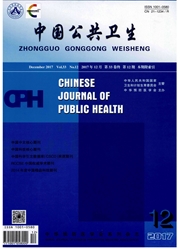

 中文摘要:
中文摘要:
目的 了解中国城乡居民两周患病未就诊行为的影响因素,为促进居民卫生服务利用提供参考。方法于2015年7—8月采用多阶段分层整群随机抽样的方法,在中国东、中、西部抽取6个省(自治区)的36个县3 186户共10 376名居民为调查对象,基于安德森卫生服务利用行为模型设计调查问卷,通过面对面入户调查的方法收集资料;使用χ^2检验和二分类logistic回归方法分析居民两周患病未就诊的影响因素。结果 居民两周患病率为19.9%,两周患病未就诊率为45.7%;经过χ^2检验和logistic回归分析结果显示,城市居民未就诊率(50.7%)高于农村(38.9%),男性居民未就诊率(48.5%)高于女性(43.6%),东部(50.8%)和西部(52.9%)居民未就诊率均高于中部(33.5%)、年龄≥80岁(52.1%)、婚姻状况为其他(49.6%)、文化程度初中高中及中专(51.0%)、人均年收入3 001~5 000元(52.3%)、到二级及以上医疗机构时间〉60 min(57.3%)的居民未就诊率较高,差异均有统计学意义(均P〈0.05)。结论 中国城乡居民两周患病未就诊的影响因素为城乡、地区、年龄、性别和到二级及以上医疗机构时间;应对居民进行健康宣教,科学合理配置卫生资源。
 英文摘要:
英文摘要:
Objective To explore influencing factors of two-week prevalence of not visiting a doctor among ill residents in urban and rural China and to provide references for promoting health service utilization in the residents. Methods With multi-stage stratified cluster random sampling, all residents in 3 240 households were selected from 36 counties in 6 provinces across China. Data were collected via a face-to-face household survey using a self-designed questionnaire based on Anderson's behavior model for health service utilization. Chi-square test and binary logistic regression were used in data analyses. Results The two-week disease prevalence rate was 19. 9% among the 10 376 respondents with valid information; of the ill respondents, the two-week prevalence of not visiting a doctor was 45.7% ; the results of χ^2 test and logistic regression analysis revealed a higher two-week prevalence rate of not visiting a doctor among the ill residents in urban areas than among those in rural areas (50.7% vs. 38.9% ), among the ill males than among the ill females (48. 5% vs. 43.6% ), and among the ill residents in eastern and western China than among those in central China (50. 8% and 52. 9% vs. 33.5% ). Significantly higher two-week prevalence rate of not visiting a doctor was verified among the ill residents aged 80 years or older (52. 1% ) ,with marital status of other than married or single (49. 6% ), with the education of high school or technical secondary school (51.0% ), having per capita annual income of 3 001 - 5 000 RMB Yuan (52. 3% ) ,and taking more than 60 minutes to reach a medical institution at secondary level (57.3%) (P 〈 0. 05 for all). Conclusion The influencing factors of two-week prevalence rate of not visiting a doctor among ill residents in urban and rural China include residential area, region of hometown, age, gender, and the time for reaching a medical institution at secondary level; the results suggest that health education should be promoted among residents a
 同期刊论文项目
同期刊论文项目
 同项目期刊论文
同项目期刊论文
 期刊信息
期刊信息
